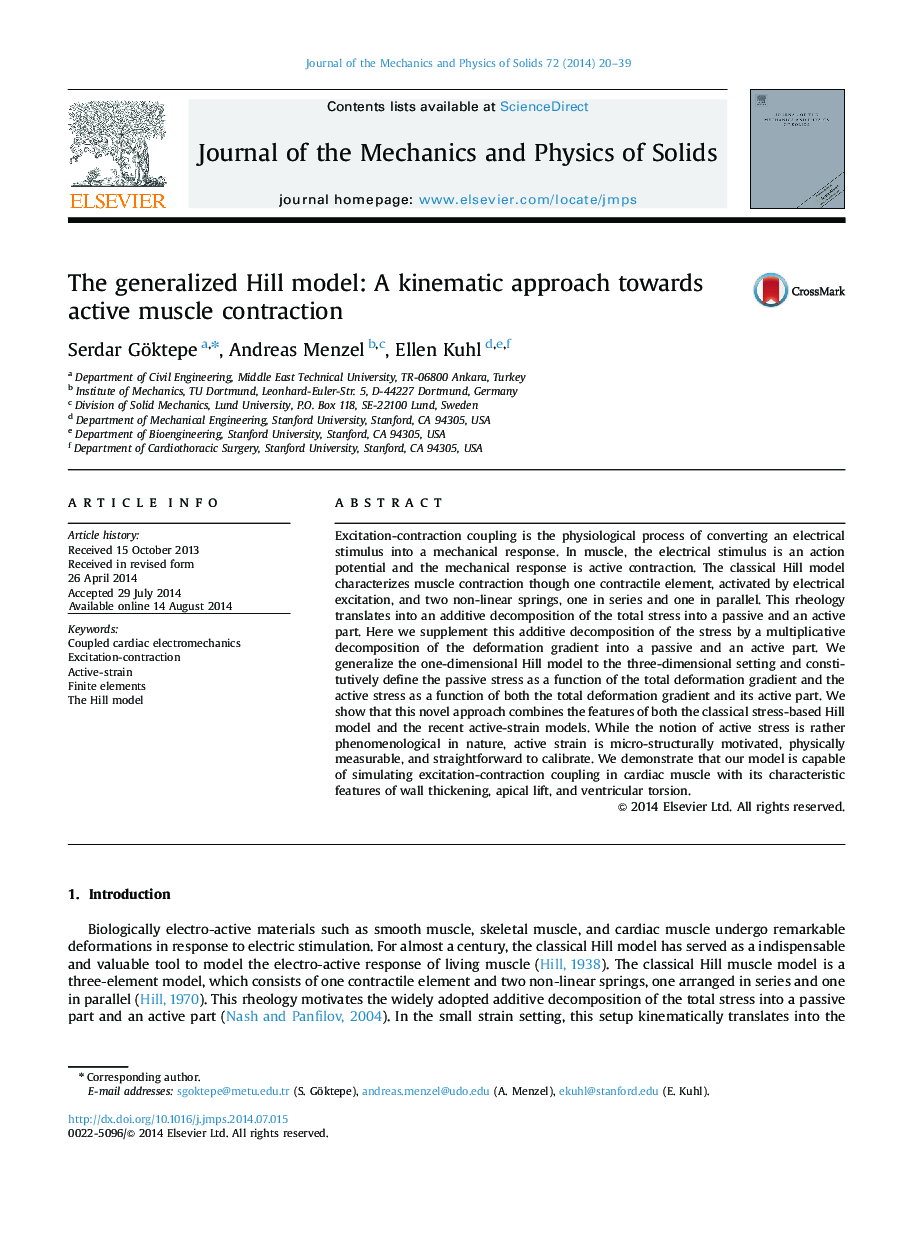| کد مقاله | کد نشریه | سال انتشار | مقاله انگلیسی | نسخه تمام متن |
|---|---|---|---|---|
| 7178172 | 1467071 | 2014 | 20 صفحه PDF | دانلود رایگان |
عنوان انگلیسی مقاله ISI
The generalized Hill model: A kinematic approach towards active muscle contraction
ترجمه فارسی عنوان
مدل کلی هیل: یک رویکرد سینماتیک نسبت به انقباض عضله فعال
دانلود مقاله + سفارش ترجمه
دانلود مقاله ISI انگلیسی
رایگان برای ایرانیان
کلمات کلیدی
الکترومکانیک قلبی همراه، تحریک-انقباض، کشش فعال، عناصر محدود مدل هیل،
ترجمه چکیده
جفتگیری انقباضی - فرآیند فیزیولوژیکی تبدیل یک محرک الکتریکی به یک واکنش مکانیکی است. در عضله، محرک الکتریکی یک پتانسیل عمل است و پاسخ مکانیکی انقباض فعال است. مدل هیل کلاسیک انقباض عضلانی را، هرچند یک عنصر انقباضی، توسط تحریک الکتریکی و دو فنر غیر خطی، یکی به صورت سری و یک به صورت موازی، مشخص می کند. این رولوژی به تجزیه افزایشی کل استرس به بخش غیر فعال و فعال تبدیل می شود. در اینجا ما این تجزیه افزایشی تنش را با تقسیم چندگانه گرادیان تغییر شکل به بخش غیر فعال و فعال فعال می کنیم. ما مدل هیل یک بعدی را به محیط سه بعدی تعمیم می دهیم و استنتاج می کند که استرس منفعل به عنوان یک تابع از گرادیان تغییر شکل کامل و استرس فعال به عنوان تابع از هر دو گرادیان تغییر شکل کامل و بخش فعال آن است. ما نشان می دهیم که این رویکرد جدید ترکیبی از ویژگی های مدل هیل بر اساس استرس کلاسیک و مدل های اخیر فعال است. در حالی که مفهوم استرس فعال به جای طبیعت پدیده شناختی است، کشش فعال، از لحاظ میکرو ساختاری انگیزه، فیزیکی قابل اندازه گیری و ساده برای کالیبراسیون است. ما نشان می دهیم که مدل ما قادر به شبیه سازی اتصال انقباضی تحریک در عضله قلب با ویژگی های مشخصی از ضخامت دیواره، آپیکالیال و چرخش بطنی است.
موضوعات مرتبط
مهندسی و علوم پایه
سایر رشته های مهندسی
مهندسی مکانیک
چکیده انگلیسی
Excitation-contraction coupling is the physiological process of converting an electrical stimulus into a mechanical response. In muscle, the electrical stimulus is an action potential and the mechanical response is active contraction. The classical Hill model characterizes muscle contraction though one contractile element, activated by electrical excitation, and two non-linear springs, one in series and one in parallel. This rheology translates into an additive decomposition of the total stress into a passive and an active part. Here we supplement this additive decomposition of the stress by a multiplicative decomposition of the deformation gradient into a passive and an active part. We generalize the one-dimensional Hill model to the three-dimensional setting and constitutively define the passive stress as a function of the total deformation gradient and the active stress as a function of both the total deformation gradient and its active part. We show that this novel approach combines the features of both the classical stress-based Hill model and the recent active-strain models. While the notion of active stress is rather phenomenological in nature, active strain is micro-structurally motivated, physically measurable, and straightforward to calibrate. We demonstrate that our model is capable of simulating excitation-contraction coupling in cardiac muscle with its characteristic features of wall thickening, apical lift, and ventricular torsion.
ناشر
Database: Elsevier - ScienceDirect (ساینس دایرکت)
Journal: Journal of the Mechanics and Physics of Solids - Volume 72, 1 December 2014, Pages 20-39
Journal: Journal of the Mechanics and Physics of Solids - Volume 72, 1 December 2014, Pages 20-39
نویسندگان
Serdar Göktepe, Andreas Menzel, Ellen Kuhl,
